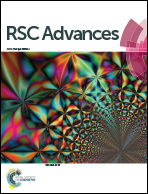Hydrogen-bonded effects on supramolecular blue phase liquid crystal dimeric complexes†
Abstract
In this study, a series of novel asymmetric hydrogen-bonded (H-bonded) dimeric complexes D/P and D/P* (proton donors D = A, A*, AF and AF*) were synthesized and self-assembled by appropriate molar ratios of H-donors (A, A*, AF and AF*) and H-acceptors (P and P*). In addition, the influences of the lateral fluoro-substituent of H-donors, the number (along with the position) of chiral centers and the molar ratio of H-donors and H-acceptors on the mesophasic behaviours (e.g., BPs) of asymmetric H-bonded dimeric complexes are investigated. Interestingly, the blue phase (i.e., BPI) was observed in complexes A*/P, A*/P*, AF*/P and AF*/P* containing at least a chiral center in H-donors (A* and AF*), including the widest BPI ranges of complexes AF*/P* (ca. 6 °C and 13 °C for 1 : 1 and 3 : 1 mol, respectively). For the first time, the hydrogen-bonded effects on supramolecular blue phase LCs are compared with their analogous covalent diads. Based on our theoretical calculation, we discovered that the bend angle plays an important role in manipulating the existence of the blue phase, which is preferred to appear at the bend angle within 132.1–152.9°. Hence, owing to inappropriate bend angles, both H-bonded dimeric complex A/P* and covalent diad A*-P (with bend angles of 162.0° and 126.5°, respectively) did not possess any blue phase.


 Please wait while we load your content...
Please wait while we load your content...